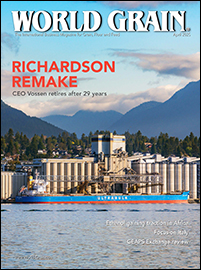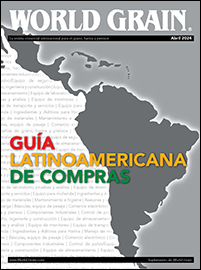By Melissa Alexander
The United States benefits from a range of climates and vast natural resources highly suitable for agriculture. As the population continues to urbanize and farms grow larger, the long-standing trend of consolidation among U.S. producers, handlers and processors has continued into the 21st century.
In the past year, the United States has made significant changes in its domestic agricultural policies. Turning away from many of the market-orientated concepts of the 1996 legislation dubbed "Freedom to Farm," Congress in 2002 enacted a farm bill that restores and/or expands programs that will provide unprecedented levels of support to farmers. This support will be achieved in a three-part approach — price support loans for wheat, maize, soybeans and rice at the highest levels since the mid-1980s; guaranteed annual direct payments; and re-establishment of the target price program. All three of these support methods have been tried in the past, but the 2002 act marks the first time they have been combined.
In 1996, the Congress sought to reduce the role of government in agriculture and move growers toward producing for the market’s needs, not for government payments. Declining direct payments to producers were seen as a means of "weaning" growers from reliance on government programs and facilitating a transition to a more market-orientated agricultural regime.
But crop prices plummeted in the late 1990s and remained low, and Congress each year authorized emergency bailouts to supplement farmers’ incomes that ultimately totaled more than U.S.$30 billion. The new 2002 law’s counter-cyclical payments are intended to eliminate these ad hoc bailouts, and the new payments will automatically be made when prices move down to legislated levels.
One difference between the 2002 law and previous target price schemes is that payments are not tied to farmers’ actual production. Although payments again will be made when market prices fall below legislated target prices, payments will be based on historical planted area and yield formulas, not on each year’s actual output.
Thus, farmers are eligible for deficiency payments even if land is idled for the entire season. This feature was designed to discourage farmers from "planting for the government payment" every year.
The new farm bill also provides for a significant increase in spending on conservation and increases the limit on area that may be idled under the Conservation Reserve Program to 39.2 million acres (15.7 million ha) from 36.4 million (14.6 million ha) under the 1996 law. The trade title provides for increasing spending on the Market Access Program and for the Foreign Market Development Cooperator Program.
The 2002 legislation has come under attack from several U.S. sectors. Urban interests have blasted the cost, which some have estimated will add U.S.$80 billion more than the previous legislation during the life of the bill.
Meanwhile, champions of a market-orientated agriculture bemoan the move away from that concept to more government intervention. Although the new target price plan may be less distorting to markets than previous versions, the loan rate increases could encourage more output, and, as one critic warned, "every time the loan rate has been raised to a high level in the past, production controls soon follow."
Aside from attracting domestic criticism, the U.S. farm bill drew a loud chorus of boos from the international community. Long the world’s self-proclaimed promoter of minimal governmental influence in agriculture, the United States, by virtue of enacting the 2002 farm bill, found itself nearly universally derided as a hypocrite.
This outrage reflected not just moral indignation, but a belief that the United States was in violation of its trade commitments and that it had undermined its credibility in further World Trade Organization negotiations.
Canada Agriculture Minister Lyle Vanclief called the new commodity support system "a drive toward protectionism" in violation of WTO rules, while E.U. Commissioner for Agriculture, Rural Development and Fisheries Franz Fischler said the farm bill not only would shield U.S. farmers from low prices and stimulate overproduction, but was inconsistent with the U.S. trade agenda and would hamper WTO reforms.
"We cannot negotiate on the basis of do as I say, not as I do," Fischler noted.
WHEAT AND FLOUR MILLING
The United States traditionally has been among the "Big Five" wheat nations in terms of global supplies and trade. A variety of U.S. classes and qualities, combined with a sophisticated and efficient marketing and transportation system, generally has resulted in reliable supply levels.
In the past few years, U.S. wheat area and supplies have been dropping. Plantings declined each year, and harvest in the current season was curtailed sharply by a devastating drought, which will result in the lowest U.S. wheat carryover in decades.
U.S. millers looking to Canada for supplemental wheat supplies this season have found little relief, as severe drought also afflicted that country. Consequently supplies of milling quality wheat are expected to be extremely tight until the winter wheat harvest gets under way in May.
But prospects for 2003-04 crop-year supplies are brighter, with needed precipitation falling in key areas. Planted acreage, encouraged by higher prices, also has been estimated to increase by 6%.
For the U.S. flour milling industry, the trend during the last few decades of the 20th century featured increasing production and rising per capita consumption. U.S. domestic markets for flour are primarily industrial and are highly varied, and end products range from niche items such as bagels and tortillas to in-store baking and wholesale branded bread, snacks and cakes.
Industry analysts cited several reasons for the extraordinary expansion in flour use between the 1970s and the late 1990s: lifestyle changes, including growing demand for fast food and other convenience foods; new awareness of the nutritional benefits of bread; and demographic changes, including increased exposure to and appreciation of grain-based ethnic foods.
But at the start of the 21st century, the situation became more problematic. From a production peak in 2000, flour output in 2001 slid by about 4% and was down 2% from 1999. Meanwhile, per capita consumption, on a steady rise for much of the past several decades, posted its first year-to-year decline in 1998 and has been erratic since.
The change created overcapacity problems for the U.S. milling industry over the past several years, as expansion during the growth years got ahead of demand. As a consequence, the 2001 U.S. flour milling rate of grind, measured by daily output as a percentage of daily capacity, stood at 86.0% in 2001, below the 10-year average of 90.4% and the lowest in at least 10 years.
This development forced millers to re-assess investments and adjust accordingly. For example, at the end of 2002, 177 U.S. wheat flour mills were in operation, down seven from the same time a year earlier, while daily capacity in the same period declined by about 2% to slightly under 65,000 tonnes of flour.
The 2002 numbers reflected an 11% drop in the number of mills just since the end of 2000. The numbers also showed an 8.2% decline in daily capacity since the 20-year peak of nearly 70,000 tonnes at the end of 2000.
Major milling plants that closed in the past two years include a 748-tonne facility in Seattle, Washington, in December 2001, just months after it was acquired by Pendleton Flour Mills from Fisher Mills, Inc.; an ADM mill in Des Moines, Iowa, two in Kansas and one in Louisiana, cutting 998 tonnes from ADM’s total daily capacity; and a ConAgra Maple Leaf Milling facility in Buffalo, New York, with 1,300 tonnes of capacity. And, in the largest U.S. capacity reduction in decades, Cargill Flour Milling in April 2001 closed three mills with a total of 1,300 tonnes capacity, or 11% of the company’s total.
Cargill also was active in altering its business plan in 2001-2002 with the creation of a milling venture with CHS Cooperatives, which formerly operated the seventh-largest U.S. milling company. That joint venture, named Horizon Milling, L.L.C., was finalized in 2002, bringing together 20 wheat flour mills and three durum mills and creating the largest U.S. milling company with total daily capacity of 293,000 cwts, or 13,290 tonnes in terms of flour.
ADM Milling Co., for many years the largest U.S. milling company, ranked second at the end of 2002, with 24 wheat flour mills and a total daily capacity of 13,063 tonnes of flour. ConAgra Foods, ranked third, had total daily capacity of 11,344 tonnes of flour by the end of 2002.
As 2003 began, the U.S. flour milling industry was focusing on several important issues affecting consumer demand and business and operating strategies. The resurgence in popularity of the "anti-carbohydrate" Atkins diet, changing retail distribution and flour-based products with extended shelf life, controversy over the introduction of genetically modified wheat and the looming ban on methyl bromide represented some of the industry challenges that will be watched closely.
COARSE GRAINS AND FEED
As with wheat, the United States is a major player in global coarse grains. The country remains the largest single producer, user and exporter, although U.S. export market share has slipped slightly in recent years with the onset of competition in maize markets from China.
The U.S. feed industry is an immense sector ranging from fairly simple on-farm mixers to sophisticated compound feed manufacturers to large, integrated international livestock and poultry producers-processors. The American Feed Industry Association, the industry’s primary educational and legislative lobbying group, boasts nearly 700 member companies representing nearly 75% of the commercial feed and pet food sold annually in the United States. According to the U.S. Census Bureau, the value of non-pet-food animal feed sales stands at more than U.S.$19 billion.
The fastest-growing U.S. feed use segment is aquaculture. Between 1980 and 1998, the value of U.S. aquaculture production rose more than 400% and today stands at around U.S.$1 billion.
The catfish industry is the largest sector in U.S. aquaculture, accounting for almost half of all sales. Other major foodfish species grown in the United States are trout, salmon, tilapia, hybrid striped bass, sturgeon, walleye and yellow perch. With the exception of salmon, these fish are normally grown in open freshwater production systems.
Aside from fish, U.S. aquaculture also produces freshwater crawfish, mainly in Louisiana, and shrimp in brackish ponds in South Carolina, Texas, and Hawaii. The U.S. also farm-raises mollusk species such as abalone, oysters, clams and mussels. Mollusks are grown in almost every coastal area of the United States and are produced using various systems.
Over the last several years the amount of aquaculture products imported into the United States has expanded.
Domestic U.S. aquacultural production is expected to remain on the increase, although at a slower pace. Stronger U.S. economic growth in 2003 and continued expansion in the foodservice sector should translate into higher demand for seafood products, but cheap imports will continue to provide competition.
___12544___





